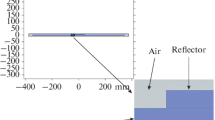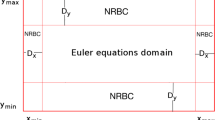Abstract
Purpose
Acoustic levitation involves no physical contact with the specimen, hence widely used for the bio/chemical studies, fluid physics studies etc. Standing wave acoustic levitation system works on resonance phenomenon. So, to obtain the right air gap/distance between the driver and the reflector surfaces for the levitation system's resonance condition is significantly important. In this paper, the finite difference method is used to calculate the air gap for the resonance between the driver and reflector surfaces. Two different 2D axisymmetric geometries of the levitation system are considered for the study. Further, the air gap is also calculated using the 2D axisymmetric model with acoustic structure interaction in the COMSOL Multiphysics software. An experimental setup is also developed to validate the numerical results. The fourth resonance mode of the standing wave acoustic levitation system is considered for the comparison of the different models.
Methods
In this paper, the Finite difference method is used to determine the resonance condition of the standing wave acoustic levitation system, which has a driver at one end and the reflector at the other. The sound source/driver is considered at the bottom, and the reflector is considered at the top. The numerical model is developed for the two different axisymmetric geometries. Then, MATLAB is used to solve these numerical models. But, other free software like OCTAVE can also be used to get the economic solution. The convergence study is performed to find out the optimum element size for geometry mesh. The finite difference results are also compared with the simulation software COMSOL Multiphysics results. Further, the experiment setup is also developed to get the experimental results which are compared with the Finite difference results.
Results
The excitation frequency of the driver is taken as 40 kHz. The resonance condition corresponding to the fourth resonance mode (for both the cases) is calculated. For both the finite difference model cases, the air gap corresponding to the fourth resonance mode is computed as 19.71 mm and 19.40 mm, respectively. Using 2D axisymmetric model of COMSOL Multiphysics, the value of the air gap between the driver surface and the reflector surface is calculated as 19.29 mm. The pressure profiles of the standing wave acoustic levitation system are also obtained and plotted using Finite difference method as well as the COMSOL Multiphysics. Further, the air gap corresponding to the fourth resonance mode is also calculated experimentally as 19.28 mm. The experimental setup of the standing wave acoustic levitation system at fourth resonance mode with three small polystyrene balls levitating freely at the pressure nodes are also shown. The small polystyrene balls are of average diameter 3 mm and the average weight of 0.15 mg.
Conclusions
In this study, the resonance condition of the standing wave acoustic levitation system is studied. The finite difference method, COMSOL Multiphysics, as well as the experimental method, are used for the study. The results (the value of the air gap between the driver and the reflector surfaces) corresponding to the fourth resonance mode are calculated and compared. Two different cases (each case has a different standing wave acoustic levitation system geometry) are solved using the finite difference method. In current study, the acoustic structure interaction was not considered. In future studies, the acoustic structure interaction can be included. This will make the numerical model closer to the actual experimental setup and will give the more accurate estimation of the resonance condition of the standing wave acoustic levitation system.





Similar content being viewed by others
Data availability
Data sets generated during the current study are available from the corresponding author on reasonable request.
Abbreviations
- \(c\) :
-
Speed of sound
- \(k\) :
-
Wave number
- \(p\) :
-
Sound pressure amplitude
- \(\Delta h_{x}\) :
-
Step size in x direction
- \(\Delta h_{z}\) :
-
Step size in z direction
- λ:
-
Wavelength corresponding to the 40 kHz
- \(\omega\) :
-
Angular frequency
- i :
-
Discretization index in x direction
- k :
-
Discretization index in z direction
References
Tian Y, Holt RG, Apfel RE (1995) A new method for measuring liquid surface tension with acoustic levitation. Rev Sci Instrum 66(5):3349–3354. https://doi.org/10.1063/1.1145506
Trinh EH, Hsu CJ (1986) Acoustic levitation methods for density measurements. J Acoust Soc Am 80(6):1757–1761. https://doi.org/10.1121/1.394290
Apfel RE (1976) Technique for measuring the adiabatic compressibility, density, and sound speed of submicroliter liquid samples. J Acoust Soc Am 59(2):339–343. https://doi.org/10.1121/1.380868
Kremer J, Kilzer A, Petermann M (2018) Simultaneous measurement of surface tension and viscosity using freely decaying oscillations of acoustically levitated droplets. Rev Sci Instrum 89(1):015109. https://doi.org/10.1063/1.4998796
Trinh E, Apfel RE (1980) Sound velocity of supercooled water down to −33 °C using acoustic levitation. J Chem Phys 72(12):6731–6735. https://doi.org/10.1063/1.439134
Trinh EH, Ohsaka K (1995) Measurement of density, sound velocity, surface tension, and viscosity of freely suspended supercooled liquids. Int J Thermophys 16(2):545–555. https://doi.org/10.1007/BF01441920
Ohsaka K, Trinh EH (1989) Melting and solidification of acoustically levitated drops. J Cryst Growth 96(4):973–978. https://doi.org/10.1016/0022-0248(89)90658-1
Vandaele V, Lambert P, Delchambre A (2005) Non-contact handling in microassembly: acoustical levitation. Precis Eng 29(4):491–505. https://doi.org/10.1016/j.precisioneng.2005.03.003
Xie WJ, Cao CD, Lü YJ, Wei B-B (2002) Levitation of iridium and liquid mercury by ultrasound. Phys Rev Lett 89(10):104304. https://doi.org/10.1103/PhysRevLett.89.104304
Xie WJ, Cao CD, Lü YJ, Hong ZY, Wei B-B (2006) Acoustic method for levitation of small living animals. Appl Phys Lett 89(21):214102. https://doi.org/10.1063/1.2396893
Zhao S, Wallaschek J (2011) A standing wave acoustic levitation system for large planar objects. Arch Appl Mech 81(2):123–139. https://doi.org/10.1007/s00419-009-0401-3
Santillan A (2011) Analysis of oscillational instabilities in acoustic levitation using the finite-difference time-domain method. IEEE Int Ultrason Symp. https://doi.org/10.1109/ULTSYM.2011.0385
Yadav S, Gupta A (2019) Maximization of acoustic levitating force for a single-axis acoustic levitation system using the finite element method. Chin Phys Lett 36(3):034302. https://doi.org/10.1088/0256-307X/36/3/034302
Xie WJ, Wei B (2001) Parametric study of single-axis acoustic levitation. Appl Phys Lett 79(6):881–883. https://doi.org/10.1063/1.1391398
Oran WA, Berge LH, Parker HW (1980) Parametric study of an acoustic levitation system. Rev Sci Instrum 51(5):626–631. https://doi.org/10.1063/1.1136268
Yadav S, Gupta A (2020) Parametric study of driver and reflector of single axis acoustic levitator using finite element method. Acoust Phys 66(3):242–249. https://doi.org/10.1134/S1063771020030094
Barmatz MB, Gaspar MS, Trinh EH (1990) Simplified rotation in acoustic levitation. J Acoust Soc Am 88(6):2897–2897. https://doi.org/10.1121/1.399647
Hatano H (1994) Axisymmetric analysis of a tube-type acoustic levitator by a finite element method. IEEE Trans Ultrason Ferroelectr Freq Control 41(5):772–777. https://doi.org/10.1109/58.308513
Andrade MAB, Perez N, Buiochi F, Adamowski JC (2011) Matrix method for acoustic levitation simulation. IEEE Trans Ultrason Ferroelectr Freq Control 58(8):1674–1683. https://doi.org/10.1109/TUFFC.2011.1995
Andrade MAB, Buiochi F, Adamowski JC (2010) Finite element analysis and optimization of a single-axis acoustic levitator. IEEE Trans Ultrason Ferroelectr Freq Control 57(2):469–479. https://doi.org/10.1109/TUFFC.2010.1427
Kinsler LE, Frey AR, Coppens AB, Sanders JV (2000) Fundamentals of acoustics, 4th edn. John Wiley & Sons, Inc
Author information
Authors and Affiliations
Corresponding author
Ethics declarations
Conflict of Interest
On behalf of all authors, the corresponding author states that there is no conflict of interest.
Additional information
Publisher's Note
Springer Nature remains neutral with regard to jurisdictional claims in published maps and institutional affiliations.
Rights and permissions
Springer Nature or its licensor (e.g. a society or other partner) holds exclusive rights to this article under a publishing agreement with the author(s) or other rightsholder(s); author self-archiving of the accepted manuscript version of this article is solely governed by the terms of such publishing agreement and applicable law.
About this article
Cite this article
Yadav, S., Gupta, A. Finite Difference Study to Evaluate the Resonance Condition of the Standing Wave Acoustic Levitation System. J. Vib. Eng. Technol. 12, 1923–1929 (2024). https://doi.org/10.1007/s42417-023-00953-1
Received:
Revised:
Accepted:
Published:
Issue Date:
DOI: https://doi.org/10.1007/s42417-023-00953-1




